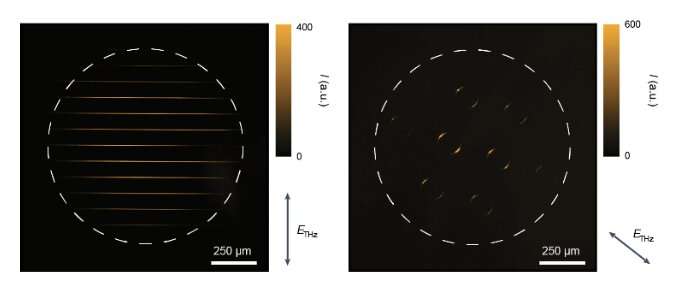A room-temperature terahertz camera based on a CMOS and quantum dots


Terahertz (THz) radiation is electromagnetic radiation ranging from frequencies of 0.1 THz to 10 THz, with wavelengths between 30μm and 3mm. Reliably detecting this radiation could have numerous valuable applications in security, product inspection, and quality control.
For instance, THz detectors could allow law enforcement agents to uncover potential weapons on humans or in luggage more reliably. It could also be used to monitor natural environments without damaging them or to assess the quality of food, cosmetics and other products.
Recent studies introduced several devices and solutions for detecting terahertz radiation. While a few of them achieved promising results, their performance in terms of sensitivity, speed, bandwidth and operating temperature is often limited.
Researchers at Massachusetts Institute of Technology (MIT), University of Minnesota, and other institutes in the United States and South Korea recently developed a new camera that can reliably detect THz radiation at room temperature, while also characterizing its so-called polarization states. This camera, introduced in a paper published in Nature Nanotechnology, is based on widely available complementary metal-oxide-semiconductors (CMOS), enhanced using quantum dots (i.e., nm-sized semiconductor particles with advantageous optoelectronic properties).

“Our previous measurements of electroluminescence from quantum dots (QDs) showed that charge transfer between them can be induced by a THz-frequency light pulse,” Keith A. Nelson, Sang-Hyun Oh and Jiaojian (Tristan) Shi, three of the researchers who carried out the study, told Phys.org via email. “The electric field of the light pulls an electron off one QD and transfers it to a neighboring QD. After the THz pulse is over (it’s usually just one cycle of the field), the electron recombines with its parent QD.”
In their previous work, Nelson and his colleagues found that an electron’s return to its original hosting quantum dot is typically accompanied by the emission of visible light. In their new study, they set out to create a device that would leverage the process they observed and the resulting light emission to detect THz pulses.
“Our objective was to develop a device that utilizes this mechanism to detect THz pulses, by upconverting them to visible light emission,” Nelson, Oh and Shi said. “We also wished to realize other novel functionalities uniquely enabled by such a novel detection mechanism.”
The CMOS-based THz camera created by the researcher was assembled in two separate stages. First, Nelson, Oh, Shi and their colleagues fabricated nanoscale field enhancement structures (i.e., patterned conducting layers with sub-micron insulating gaps in which an incident THz field is strongly enhanced). These structures were created using electron-beam lithography, a common method to write or draw patterns on substates. The second stage of the camera’s assembly entailed the synthesis of quantum dots and their deposition onto the field enhancement structures.

“The QDs that end up in the insulating gaps are subjected to the enhanced THz field. Their electroluminescence produces visible light that is detected with a conventional CMOS element,” Nelson, Oh and Shi explained. “Its actual fabrication is complex, but it is based on two existing technologies, and the processes can be separated into distinct parts. Thus, streamlined mass production should be possible and low-cost.”
In initial evaluations, the THz-detecting camera created by this team of researchers achieved remarkable results, detecting THz pulses with peak fields as low as 10 kVcm-1 at room temperature, with a fast response rate and high bandwidth. The device is also affordable and can be scaled up to wafer size for large-area imaging or other large-scale applications.
In contrast with other THz radiation detectors devised in the past, the camera created by Nelson, Oh and Shi can simultaneously detect both the intensity of THz light and its polarization states. In the future, it could thus open new exciting possibilities for the sensing and characterization of THz light.
“We now plan to improve the qTV performance even further, for instance using different QD or OLED (organic LED) materials, cooled and amplified visible detectors, even narrower insulating gaps, etc.,” the researchers added. “We conducted preliminary work on integrating qTV devices with a DC electric field, with an idea similar to the avalanche detector development, which can enhance the THz sensitivity and lower the threshold. We plan to explore this direction further to enable CW or quasi-CW THz sensing. The upconversion mechanism we uncovered is so convenient that it could even enable the development of an ultrasmall THz spectrometer, combining diameter-varying coax arrays with QDs.”
More information:
Jiaojian Shi et al, A room-temperature polarization-sensitive CMOS terahertz camera based on quantum-dot-enhanced terahertz-to-visible photon upconversion, Nature Nanotechnology (2022). DOI: 10.1038/s41565-022-01243-9
© 2022 Science X Network
Citation:
A room-temperature terahertz camera based on a CMOS and quantum dots (2022, December 8)
retrieved 8 December 2022
from https://phys.org/news/2022-12-room-temperature-terahertz-camera-based-cmos.html
This document is subject to copyright. Apart from any fair dealing for the purpose of private study or research, no
part may be reproduced without the written permission. The content is provided for information purposes only.



